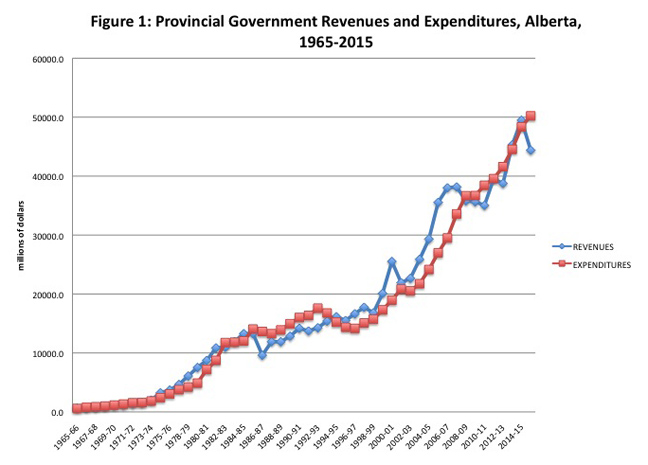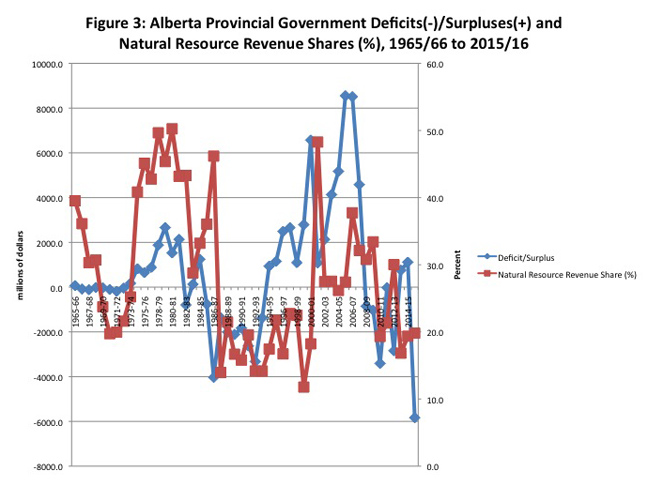A brief fiscal history of Alberta government finances
Alberta’s NDP government is expected to announce a deep budget deficit in the fall, which according to Alberta Finance Minister Joe Ceci (pictured above) is supposed to fund additional infrastructure spending and bolster GDP. Indeed, the deficit could be even larger than the $6.5 billion deficit that has already been projected. Alberta’s public finances indeed have an interesting history and now is as good a time as any to put Alberta’s finances in longer-term perspective.
Figure 1 presents revenue and expenditure data for Alberta’s provincial government over the 1965 to 2015 period taken from three sources: 1) Statistics Canada’s public finance historical data (catalogue 68-512) for the 1965-66 to 1979-80 period 2) federal fiscal reference tables for 1980-81 to 2013-14 and 3) Alberta government first quarter fiscal update and economic statement, for 2014-15 to 2015-16.

Needless to say, Alberta’s government revenues and spending have come a long way from the 1960s. In 1965-66, Alberta had revenues of $0.651 billion and expenditures of $0.581 billion for a surplus of $70 million. For 2015-16, Alberta is currently projected to have revenues of $44.388 billion and expenditures of $50.222 billion for a deficit of $5.834 billion. Alberta government revenues since the 1960s have only just kept pace with expenditures, with each growing an average of 10 per cent annually (unadjusted for inflation) with the largest annual per cent increases occurring during the boom of the 1970s.
However, since 2000, revenues have grown at an annual average rate of 5.7 per cent while expenditures have grown seven per cent. Indeed, Mark Milke has argued spending would have been much less if spending increases had merely matched population growth and inflation.
Figure 2 plots Alberta deficits and surplus since 1965-66 and reveals that over these 50 years of provincial budgets, Alberta has run a deficit 23 times—or 46 per cent of the time. The other years have all seen surpluses. While the largest nominal surpluses have been more recent, as a share of GDP they were the largest in the 1970s.

Of course, Alberta’s fiscal history is inevitably tied to natural resource revenues and the world price of oil. If one looks at Figure 3, Alberta’s deficits and surpluses are plotted alongside the natural resource share of government revenues with resource revenues obtained from Alberta’s Department of Energy.

It’s no coincidence that Alberta’s government budgets tend to surplus when natural resource revenues surge as a share of government revenues and go into deficits when those resource revenues sag.
Alberta’s economy and public finances are marked by boom and bust cycles tied to international energy prices. Over the period 1965 to 2015, natural resource revenues as a share of provincial government revenues averaged 28 per cent—but they have varied from as high as 50 per cent (in 1980-81) and as low as 12 per cent (in 1999-00). Natural resource revenues are projected to be below 20 per cent for 2015-16. Surpluses tend to be more common when the natural resource revenue share rises above its long-term average.
Running even larger deficits than those brought about by Alberta’s natural resource boom-bust cycles will not turn Alberta’s economy around in the long run and are unlikely to compensate for the role of resources in driving Alberta’s economy. What will turn around Alberta’s economy—and by extension, improve its fiscal situation—is an upturn in oil prices.
Author:
Subscribe to the Fraser Institute
Get the latest news from the Fraser Institute on the latest research studies, news and events.

